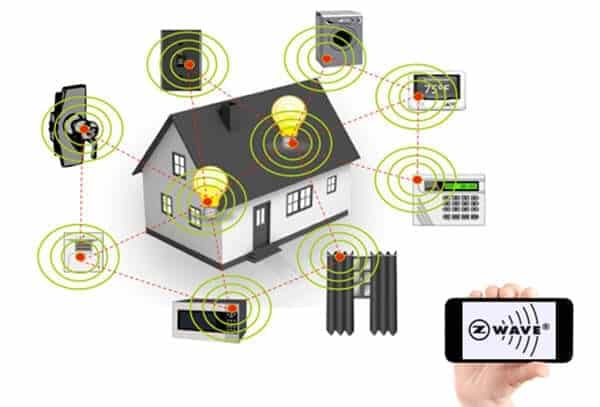Although it may seem like something very distant and even science fiction, our homes are increasingly smarter thanks to the integration of 5G technology and something that many are still unaware of: Z-Wave technology. You can see this term found in some descriptions. of light bulbs and thermostats, but do you really know what it is and what it means for our most recent future?
Technology has been changing our lives by leaps and bounds, from the way we communicate to the interaction we have with everything around us. Its function has been above all to make our lives easier, and to provide us with comforts at our fingertips that we would never have imagined. Home automation is now a reality and without realizing it, it is already taking center stage in our homes.. Let's see below what the role of z-Wave is in all this.
Article Content
What is Z-Wave?
The direction that technology is taking is heading towards this term that is so fashionable these days the internet of things. Small appliances, and all The devices around us are increasingly dynamic and interactive. Able to perform more actions and interact with us in surprising ways. So much so that we can control their tasks through voice by giving them simple instructions.
So that wireless networks do not become saturated and can support this new reality, it is necessary to have systems that are more precise and efficient. This is how Z-Wave came about, a wireless communications protocol that is used above all in home automation, or in other words the intelligence of our homes. It is a mesh network that uses low energy radio waves, so that communication flows between one device and another without complications.
It is used for much more than we imagine and will be present in the majority of devices and appliances present in our homes. This wireless network is similar to WiFi and Bluetooth, although Due to its specific characteristics it has become the best option so that our homes end up being an extension of ourselves, being able to control any element as we wish. In short, it is now possible to say that the Z-Wave communication protocol is going to be part of our future.
Z-Wave Features
Z-Wave technology will be the protagonist of our homes and what does this mean? What devices will be able to use this protocol? To give you an idea of how far it goes, it will be possible for us to control the blinds, doors, alarms, coffee makers, thermostat lamps, and any type of product that can be connected or is made for home automation. There are already many of these products that are working today, thanks mainly to the Danish technology company Zen-Systems.
But what are the special characteristics of the Z-Wave protocol, so that companies dedicated to home automation have fully committed to it? Let's see below what they have similar and different with respect to WiFi and Bluetooth. This technology shares with WiFi that it has the possibility of creating a mesh network to communicate with all possible devices. This is something that the Bluetooth protocol lacks, however. Both are wireless and reach similar distances to go from one point to another. In addition, they are based on advanced security techniques, in order to guarantee the transmission of information and that no cybercriminal can take advantage of it.
So what is the difference between Z-Wave and WiFi? WiFi operates at much higher frequencies since it is dedicated to sending and receiving enormous amounts of data, with the possibility of us playing online, transferring data and watching movies, for example. While Z-Wave works with much smaller codes, using simpler instructions such as increases the temperature of the water, close the blinds o increase the intensity of the light. It operates at much lower frequencies, thus using less energy and power. So it avoids the common (and therefore more saturated) frequencies in which WiFi operates, such as 5 Ghz and 2,4 Ghz.
How the Z-Wave network works
This protocol that we are analyzing simply has two different sets of nodes. One of them is the controller, which is the main person in charge of creating the entire network for our home. Once it connects to the Internet we can begin to run our home as we have always dreamed of, regardless of whether we are inside, since Even from kilometers away we will be able to give directions to our devices. The other node is the slave devices that are connected to each other to perform the tasks that we indicate to them.
This is very useful if we are working and suddenly remember something like turning on the heating so that the room is warmed up and we are more comfortable when we arrive. Also, Through our mobile phone through an application we can give any indication to our devices to get them going. For example, activating the lights, music and closing the blinds.
This protocol offers guarantees to consolidate itself as the main bet for most technology companies that manufacture devices for home automation. Currently there is already a grouping of up to 700 technology companies who are in charge of certifying each of the devices that come onto the market so that they are compatible with the Z-Wave network. This group is the Z-Wave Alliance.
An example of devices that already benefiting from the Z-Wave protocol are thermostats. They are capable of integrating multiple sensors to monitor the energy consumed, integrating light, temperature and humidity. These thermostats have the possibility of customizing the update frequency time of the data collected in each of the sensors. This is an example of the possibilities of using this very specific protocol, considered the most effective for home automation and smart homes.
What is Zigbee?
Zigbee is an open standard, while Z-Wave is not. This is one of the main differences between the two. While Zigbee is an open standard managed by the Zigbee Alliance, Z-Wave is a proprietary standard owned by Silicon Labs.
In this sense, the opening of Zigbee has helped you achieve further expansion, a strength that can also become a weakness when it comes to guaranteeing compatibility with elements that both companies bring to the market.
And anyone can access the Zigbee standard and adapt it to their needs since they are fully configurable elements. Philips with its line of Hue light bulbs, one of the most famous lines, uses this standard and seems to have done well.
Hue bulbs are easy to set up and expand your personal Phillips Hue wireless lighting system. With these bulbs you can bring your smart home to life with different smart lamps, switches and sensors.
In addition to the Internet of Things, the Zigbee It will also provide us with protocols for other uses such as the digitalization of health that is so fashionable and automation. These different usage scenarios within the same standard do not always work well together, although with the launch of Zigbee 3.0, all Zigbee protocols Zigbee system They are unified, so they should work together seamlessly.
Differences between Zigbee and Z-Wave
Among the differences that we find in their communication standards in terms of data transfer speeds and the working frequency of both standards, we can see that the data transfer ratio in Zigbee is higher, reaching 40-250 kbps compared to 9,6-100kbps for Z-Wave.
On the other hand, Z-Wave uses different radio frequencies depending on where we are. Thus, Z-Wave operates in the bands of 868.40/ 868.42 / 869.85 in Europe and 908,4/ 908,42 / 916 in the USA.
Brands that use Z-Wave
Of those we put on the list below, there are also manufacturers that market compatible devices for both protocols. The idea is that all companies bring products to the market that are compatible with both protocols.
- Kwikset (smart locks)
- LG SmartThinq
- Logitech Home Harmony Hub Extender
- Milo (home electronics)
- GE Appliances
- ADT Security Hub
- August (smart locks)
- Fibaro
- Honeywell (thermostats)
- GE Appliances
- Samsung SmartThings
- Somfy
- Yale (Smart Locks)
- Wink hub
Conclusion regarding Z-WAVE standards
There is no standard that is better than another, but it will depend on the needs we have. In this sense, it is key to be clear What will be the number of devices that we plan to integrate into our network, and take into account the distance among them.







